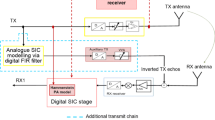Abstract
Full duplex communication highly improves spectrum efficiency of a wireless communication link. However, when it is applied to a cellular network, the capacity gain from this technology remains unknown. The reason is that full duplex communication changes the aggregate interference experienced by each communication link in cellular networks. In this paper, the capacity gain from full duplex communication is studied for cellular networks of 4G and beyond, where the same frequency channel is adopted in each cell. A two-layer Poisson point process (PPP) is adopted to model the network topology, and stochastic geometry is employed to derive the coverage probability and the average capacity of typical link in a cellular network. On the basis of these derived parameters, the capacity gain from full duplex communication is determined. Numerical results reveal that without mutual interference cancellation (MIC), the capacity gain is small under various power levels; with perfect MIC at base stations, the capacity gain can exceed 60%; with imperfect MIC at base stations, the capacity gain decreases quickly even with a slight drop of MIC performance.
Similar content being viewed by others
References
DUARTE M, DICK C, SABHARWAL A. Experimentdriven characterization of full-duplex wireless systems [J]. IEEE Transactions on Wireless Communications, 2012, 11(12): 4296–4307.
JAIN M, CHOI J I, KIM T M, et al. Practical, realtime, full duplex wireless [C]//Proceedings of the 17th Annual International Conference on Mobile Computing and Networking. Las Vegas, Nevada: ACM, 2011: 301–312.
BHARADIA D, MCMILIN E, KATTI S. Full duplex radios [C]//Proceedings of the ACM SIGCOMM 2013 Conference on SIGCOMM. [s.l.]: ACM, 2013: 375–386.
TANG A M, WANG X D. Balanced RF-circuit based self-interference cancellation for full duplex communications [J]. Ad Hoc Networks, 2015, 24: 214–227.
XIE X F, ZHANG X Y. Does full-duplex double the capacity of wireless networks? [C]// IEEE Conference on Computer Communications. [s.l.]: IEEE, 2014: 253–261.
KHOJASTEPOUR M A, SUNDARESAN K, RANGARAJAN S, et al. Scaling wireless full-duplex in multi-cell networks [C]//IEEE Conference on Computer Communications. [s.l.]: IEEE, 2015: 1751–1759.
ANDREWS J G, BACCELLI F, GANTI R K. A tractable approach to coverage and rate in cellular networks [J]. IEEE Transactions on Communications, 2011, 59(11): 3122–3134.
NOVLAN T D, DHILLON H S, ANDREWS J G. Analytical modeling of uplink cellular networks [J]. IEEE Transactions on Wireless Communications, 2013, 12(6): 2669–2679.
STOYAN D, KENDALLW S, MECKE J. Stochastic geometry and its applications [M]. Chichester: Wiley Chichester, 1995.
GOYAL S, LIU P, HUA S, et al. Analyzing a fullduplex cellular system [C]//47th Annual Conference on Information Sciences and Systems (CISS). [s.l.]: IEEE, 2013: 1–6.
GANTI R K, HAENGGI M. Interference and outage in clustered wireless ad hoc networks [J]. IEEE Transactions on Information Theory, 2009, 55(9): 4067–4086.
SHANNON C E. A mathematical theory of communication [J]. Mobile Computing and Communications Review, 2001, 5(1): 3–55.
Author information
Authors and Affiliations
Corresponding author
Rights and permissions
About this article
Cite this article
Tang, A., Huang, H. & Wang, X. Full Duplex Communications for Next Generation Cellular Networks: The Capacity Gain. J. Shanghai Jiaotong Univ. (Sci.) 23, 11–19 (2018). https://doi.org/10.1007/s12204-018-1903-3
Received:
Published:
Issue Date:
DOI: https://doi.org/10.1007/s12204-018-1903-3
Key words
- full duplex communication
- cellular networks
- capacity gain
- mutual interference cancellation (MIC)
- stochastic geometry




